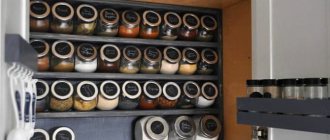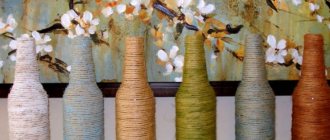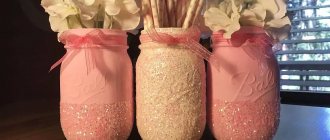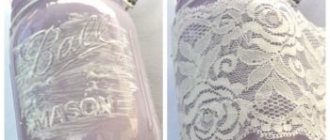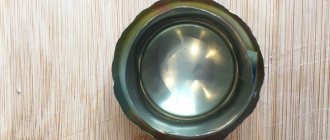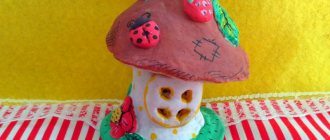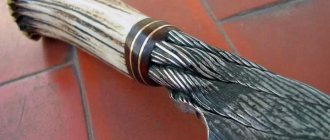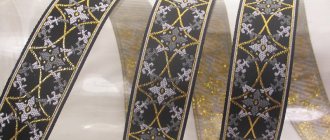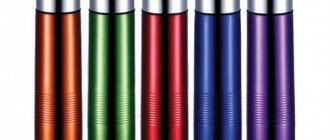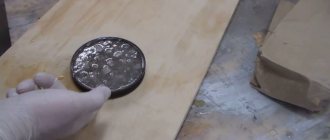The kitchen is the small world of every housewife. And everyone, without a doubt, wants to make this place ideal: beautiful, comfortable and neat. But the kitchen is not only a place for culinary masterpieces. It is also a great platform for creativity. Every day in the process of cooking, necessary and unnecessary jars remain. Some people store them on the top shelves of pantries, some on the balcony, some throw them away. In this article we will tell you how to make beautiful and convenient jars for cereals with your own hands, both from unnecessary jars and from the ones we are used to.
In addition to the fact that storing cereals can be made beautiful and even decorate the kitchen, it is also a more hygienic storage method. Such a container will not harbor food moths or other insects.
One of the common methods for making bulk jars is decoupage. This art has gained great popularity. Due to the ease of execution, the cheapness of the material and the constant revival of old things, decoupage was called the art of the poor. It was first noticed by the Germans, who began to transfer the drawings first to furniture, and then to glass and metal.
Preparation before work
Before you start directly decorating the jars with your own hands, you should think through all the nuances that relate to this procedure. Preparation consists of several main stages:
- First, naturally, the workplace is prepared. Usually this is a table whose surface is covered with film or newspapers.
- Depending on the types of materials that will have to be worked with, containers and storage containers are prepared.
- Selection of material for decoration. This list will depend on the type of finish. In most cases, a means is required to attach decorative elements to the surface of the can. It's better to use a glue gun.
- Additional means are selected to clean the surface of the cans. For metal ones it can be sandpaper, for glass - acetone, clay ones are not specially treated.
The choice of all materials and the cans themselves depends on where and how the finished decorative product will be used. It is also important to think about the design of the containers. It can first be embodied on paper, and only then transferred directly to the surface.
What materials are best to use
There are no special restrictions on the choice of material . Perfect for:
- plastic;
- glass;
- steel;
- ceramics.
Cereals must be immediately poured into a jar and not left in plastic bags.
Otherwise, mold may appear, which can lead to the appearance of toxic microorganisms and simply an unpleasant odor. The product can no longer be eaten.
Before you pour the cereal into a jar, be sure to check it for the presence of insects (especially flour). There may be a Surinamese flour beetle living there, which not only eats the product, but also contaminates it. Eating such cereals can lead to poisoning.
If you choose a plastic jar, make sure it is of good quality.
Otherwise, an unpleasant odor may arise, which over time will be transferred to the cereals.
It is also worth remembering that metal containers retain the same odors for a long time.
Decoration of tin cans
The decor of tin jars is considered the simplest. This item can be used to decorate a kitchen, hallway or corridor. Since tin cans are quite durable and practically not subject to mechanical damage, they are often used as flowerpots outdoors.
The decor of the jar begins with its preparation:
1. Using pliers and a file, remove sharp edges where the cover is cut.
2. Using a nail or drill, make several holes in the bottom so that when watering, excess water can pour out.
3. Use sandpaper to remove the factory paint from the surface.
4. Buy plastic or clay saucers in accordance with the diameter of the container, if the jars will stand. When placed vertically, such an element is not needed.
Banks made from this material are usually painted with facade paint, although regular paint can also be used. Painting can be a solid color or using stencils. The container can be decorated with additional elements: beads, ribbons and glass, twigs, bark and wire.
To be able to hang the jar, you can make a handbag out of macrame-style threads or use regular wire to make a handle like on a bucket.
Such products are used as organizers for pencils and pens, towels in the bathroom, small screws and nails in the shed. Decorated tin cans are often used as candlesticks. To do this, holes are punched in the body of the container in the form of a pattern.
On video:
master class on decorating a tin can.
DIY spice jars
Making your own set for seasonings allows you to solve the problem of accumulated empty containers and save on the purchase of household utensils. This is also a great opportunity to bring your idea to life, to create things that cannot be bought. For creative people, the process itself will bring a lot of pleasure, and the results will delight loved ones.
Decorating glass jars
Good use in the household can be found for containers of sour cream, yoghurt, and baby food. The main thing is that the containers have tight-fitting lids. Before turning a collection of glass jars into a beautiful set, they must be thoroughly washed and the paper labels removed.
You need to prepare:
- PVA glue;
- tassels;
- scissors;
- paper napkins with a beautiful image;
- thin file;
- putty;
- acrylic paints;
- small plastic bag;
- varnish
When the workplace is prepared and everything you need is at hand, start decorating.
Step-by-step description of the process:
Degrease jars with alcohol or acetone. On a napkin, separate the white layer from the colored one and cut out a motif of a suitable size. Carefully apply PVA to the application site. Pour a puddle of water onto the file. Place the cut out silhouette face down in the liquid. Carefully smooth out all wrinkles and folds with your fingers. Slowly drain excess liquid from the file. Attach the file with a napkin to the area coated with glue and smooth out all errors through the cellophane, remove bubbles. Remove the file and coat the top with PVA applique. Mix the putty with PVA (ratio 1: 1) and put the mixture in the corner of a durable plastic bag, secure with a knot for convenience. Just cut off the corner just a little and, squeezing out the putty, draw a convex ornament or floral patterns around the image. Dry and tint in the desired color with acrylic enamel, leaving a transparent window to see the contents. Apply varnish when everything is completely dry.
Decoupage will help out when there is an indelible design on the can, and putty decor will mask unnecessary raised inscriptions well.
Artificially aged food-grade plastic containers
The master class will help those whose kitchen in the Provence or Shabby chic style is so difficult to find suitable decorative utensils. Vintage spice boxes made from a regular store-bought plastic set will fit well into the interior.
For this you will need:
- PVA glue;
- brushes;
- acrylic paint and contours on glass;
- labels with the name of spices, printed on a printer;
- hair dryer;
- varnish
To ensure that the glue adheres well to plastic products, they are degreased and treated with fine sandpaper.
Instructions:
- Using a wide brush, apply a dense, uniform layer of glue over the entire surface.
- When the PVA sets into a thin but strong film, cover the jar with a layer of paint.
- Dry with warm air using a hairdryer until cracks appear.
- Using a piece of rag, rub paint of a contrasting or metallic shade into the completely dry cracks, trying not to go into the main tone.
- Labels are applied using decoupage method.
- The stained glass contour is used to decorate the borders of the application with lines or dots.
- Cover with varnish.
Antique craquelure can be made using eggshells, gluing them like a mosaic. The scuffed effect is created with bitumen varnish; it can be found in an art store.
Stained glass painting
A great idea to add color to a minimalist modern kitchen design. Only clear glass jars will do. Decorated tall narrow vessels look good; they take up little space, but hold a large volume and make it convenient to store spices in the kitchen.
For stained glass decor you will need:
- brush with natural bristles;
- stained glass paints and contours;
- napkins or cotton pads for correcting errors, alcohol;
- a sheet of paper with a printed pattern or image.
The containers are first thoroughly degreased. Then the sheet is placed inside with the pattern facing outward to make it easier to navigate. You can first make a sketch with a thin marker.
The following actions:
- The silhouettes of the details are drawn with contours, maintaining the continuity of the line and the closedness of the outlines.
- The elements are poured gradually, being careful not to smear the already applied layers.
- Dry in the oven at 150° for about half an hour.
- Varnish the product.
To hide the inscriptions on the lids, they are wiped with alcohol and covered with aerosol paint of any suitable shade.
Decorating glass jars
The decor of a glass jar is more varied; moreover, this product has a wider range of uses compared to its tin counterpart. Since the shapes, sizes and colors of glass jars can be varied, the methods of use are correspondingly different.
Storage for spices
Small jars, such as baby food, can be reused for spices. It is better to decorate jars for the kitchen with your own hands in a minimalist style so that the decorative elements do not fall off and fall into the food.
First, the factory label along with the sticky glue is removed from the glass. You can make your own decorative sticker from paper or you can paint it directly on the jar with paints. After this, you should decorate the lid. Most often, decoupage technique is used for this. But you can also paint the surface or cover it with gift paper.
On video:
decoupage of glass jars.
For cosmetics and bath accessories
Larger jars are used to make containers for bathrooms and decorative cosmetics. Often, the decor of the cans in this case is minimal and concerns mostly the lids. It is decorated with beads that serve as handles. For a more romantic style, the container itself can be decorated.
The most common decorative elements are ribbons, beads or beads, and combined weaving of them is also possible. Often the entire jar is simply sprinkled with glitter and opened with colorless varnish.
An interesting option is to decorate a glass jar using the dot painting technique. The result is very impressive.
On video:
decor of jars for the bathroom.
Jar as a candlestick
Often candlesticks or vases are made from such fragile jars. Making such a product is very simple. Since in both the first and second cases the product is subjected to use in extreme conditions, the only correct solution would be artistic coloring.
All kinds of patterns and designs are created with acrylic paints; in extreme cases, it can even be nail polish.
These are the main areas of application for decorative glass jars, but their number can be easily increased. The main thing is to think about the conditions under which the product will be used in order to select the appropriate decoration technique.
On video:
decorative candlesticks from jars.
Solid storage options
To say that there are many ideas for storing spices in the kitchen is an understatement. It all depends on the volume of spices, the space available in the kitchen and the frequency of their use. If they are used very often, and there are always a lot of spices in stock, it is worth taking care of a thorough, spacious storage. You will have to spend time and not a lot of money to create it, but you will be able to create a system for storing spices in the kitchen with your own hands.
Niche in the wall
To create it, you can use a wall near the stove, but not too close, so that the spices do not overheat. The depth of the niche corresponds to the size of the jars used for storage. The height is a multiple of the height of the cans plus 4-5 cm on each shelf to make it convenient to reach.
Jars for storing spices in the kitchen using this method should be chosen from tinted glass or plastic, since there will be no doors in the niche. Those spices that are used most often can be stored in any jars, since they simply will not have time to spoil.
Arranging storage if you already have a niche is not difficult. To do this, you need to install the shelves at the correct height. If the depth of the niche is slightly less than the diameter of the can, then you can stretch a rope, an elastic band, or nail thin strips of wood with a small indentation (up to 2 cm). If this option does not fit into the style of the kitchen, then metal strips will do. You can buy them in the store.
If the depth matches the size of the cans, then no limiters need to be installed.
Stylish spice storage option for modern kitchens
Boxes
You can create convenient storage space using drawers and baskets. Moreover, both horizontal and vertical ones are suitable.
The first option is horizontal, that is, ordinary kitchen drawers. In order for spices to be conveniently placed in them, the drawers must be deep enough. Storage options:
In order for the jars to be placed comfortably “lying down”, you need to make steps for them, but not at a right angle, but at a sharp angle. This way the contents of the jars will be easy to see. Use special plastic boxes with handles that fit into the kitchen drawer. If the jars are small, then they can be placed in a box. And for easy identification of the seasoning, stick a sticker with a signature on the lid.
One drawer can store spices in jars and open ones.
Vertical drawers are often included in modern kitchens; they are also convenient for storing spices. Such a box looks like a long, deep storage without side walls. Sides or metal strips prevent cans from falling. This box moves along guides located at the bottom, so there is no need to overload it.
The same type of box, although it will most likely be a pull-out wall, can be made behind the refrigerator if there is a distance of 15-20 cm between the wall and the household appliance. It will have certain modifications:
One wall is covered with fiberboard and plywood. It is necessary to have low sides, approximately 1/3 of the height of the shelf. Pulls out on wheels.
IKEA spice drawer design
Non-standard version of a spice box
Advice! In this spacious storage you can store not only spices, but also canned goods, sauces, and useful kitchen utensils.
Trendy decorating ideas
In addition to the standard DIY decoration of jars, non-etching methods of decorating them are often used. Recently, natural and organic materials have become increasingly popular, which, at least in a minimal amount, simply must be present in the interior of the room.
One such material is textiles, in particular burlap. With its help, you can create stunning compositions on any surface, and jars made of any material are no exception. You can sew decorative covers, flowers from burlap and glue them to the surface, just wrap the container around the perimeter.
Additional decoration can include: cereals, coffee beans, beans, twigs and much more. Similar to burlap, knitting thread can be used.
Another interesting solution in the field of decorating jars was the vine. In addition to its aesthetic value, it also protects the jars from mechanical stress. Thanks to the wicker weaving technique, you can create a variety of compositions in the form of covers and cocoons, which can additionally be decorated or painted with other colors, forming an interesting pattern.
Decorating your home is easy using scrap materials. Glass and tin jars that are thrown away as unnecessary can become the basis for creating attractive decorative items. Just look at the photo of decoupage cans to understand that in this way you can make the kitchen cozy, while the costs will be minimal.
Making containers using wine bottles
If you don’t find unnecessary jars, you can get by with bottles. The result will be unusual kitchen devices that do not allow ultraviolet rays to pass through and will protect cereals.
You will need:
1) Wine bottles;
2) Cork sheet;
3) Glass cutter.
Stages of work:
1) Using a glass cutter or grinder with a special disc, we saw off the neck of the bottle, obtaining an even container. Sand the edges.
2) Cut out even circles from a cork sheet, the diameter of which will be equal to the size of the resulting bottle holes. We insert the improvised lids into the container, tightly closing the hole.
The cereal jar is ready! During production, you can use bottles of unusual shape or with a pattern, which will give the finished product even more originality and beauty.
Below are photos that will demonstrate decor options for cereal jars and inspire you to create your own original helpers in the kitchen.
Decoupage glass jar
In the kitchen, the housewife uses jars and jars to store bulk products and spices. It’s boring to store food in simple glass containers, so try to create a decoupage glass jar that will support the style of the entire room and become a functional and attractive decorative item.
To work you will need:
- any jars you want to transform;
- acrylic primer;
- napkins with a pattern;
- PVA glue or special decoupage glue;
What are the best containers for bulk products?
In order to ensure that all small products are in the same jars, you can immediately purchase a set of containers for storing bulk products. Today, the market offers kitchen appliances made from various materials.
- plastic;
- glass;
- ceramic;
- metal;
- wooden.
Containers for bulk products are also produced with a simple lid, a dispenser and the ability to vacuum. Before purchasing, it is recommended that you familiarize yourself with the advantages and disadvantages of each individual type. It is better to purchase products from trusted places and it is advisable that the seller has a quality certificate, because the material will come into contact with the products.
Plastic containers for bulk products
These are the most popular and sought after containers among housewives. Such jars for storing cereals are available in different shapes, colors and volumes. When choosing such products, it is important to pay attention to the smell; it should be barely noticeable, otherwise it is better not to buy such products. Modern sets of containers for bulk products consist of containers of different sizes that can be easily placed inside each other, while significantly saving space when not needed. Among the advantages of this type are:
- low cost;
- lightness of products;
- large selection of shapes and colors;
- ability to withstand low temperatures.
The disadvantages include:
- deformation when heated;
- cracking after time;
- During operation, the sealing properties are lost.
Glass containers for bulk products
The shape of such products is often similar to plastic containers. Glass jars for storing bulk products are safe and hygienic. The range of products is constantly expanding in accordance with the wishes of customers. The lids on such containers can be plastic, metal or glass. Additionally, there is a choice of closures: snap, twist and lock. A glass container for bulk products for the kitchen has the following advantages:
- transparency of the walls;
- ease of cleansing;
- absence of foreign odors;
- preservation of the aroma of the product;
- lid closure tightness.
Among other things, such plexiglass containers for bulk products also have some disadvantages:
- heaviness of products;
- high price;
- intolerance to sudden changes in temperature;
- fragility.
Ceramic containers for bulk products
These products have the same characteristics as glass ones, but they come in a wide variety of colors. Such containers are often marked with an image that corresponds to the product that is inside. Ceramic storage jars have the following advantages:
- can be used as decorative elements;
- tightness of the lid;
- ease of care;
- no foreign odor.
Such containers for pasta and other bulk products have certain disadvantages:
- with frequent opening, the seal is lost;
- when heated or cooled, the appearance deteriorates;
- heavy weight and fragility of products.
Metal containers for bulk products
Among all the options offered on the metal products market, it is recommended to pay attention to stainless steel or food-grade aluminum; they are not subject to corrosion. Products are available in different forms. Lids come with threads and latches. Beautifully painted jars can become an original decoration for a kitchen in a retro or country style. Such tin containers for bulk products have the following advantages:
- ease;
- strength;
- no penetration of sunlight.
Among the disadvantages are:
- prohibition on heating in the microwave;
- corrosion may occur;
- Inexpensive products have a metallic taste.
Wooden containers for bulk products
These containers are the least practical. Often this set of jars for storing bulk products is used as decorative elements in the kitchen and this is their advantage. The disadvantages include:
- lack of a sealed lid;
- high absorption of moisture and odors;
- difficulty in cleansing;
- high price.
Step-by-step instructions for beginners
First of all, clean and dry jars will need to be degreased using any alcohol-containing product. Then cover the outer surface of the jar with soil using a sponge. To make the drawing brighter, you need to apply the primer in a few words.
Second step: using fine sandpaper, level the surface of the container.
Cut out the fragments you like from a napkin or decoupage card and make a rough composition. Apply PVA glue to the primed surface, then apply a napkin.
Place a piece of polyethylene or a stationery file on top of the napkin, gently press and smooth the picture, starting from the middle and moving towards the edges.
After drying, you can add new fragments or paint the background with acrylic paints. If the jar has a lid, coat it with primer, then decoupage the lid with acrylic paint or the above method.
The last stage is varnishing. It needs to be done in several layers. This will preserve the craft for a long time and allow you to wash the jar.
In the same style, you can decoupage coffee cans to store tea, bulk products or spices: they will add a special flavor to your kitchen.
In the style of minimalism
This decor will allow you to view the contents of the jar in full. If this is not necessary, they can be decorated in any color. This decor does not require much effort and does not imply any skills or abilities.
If you couldn’t find slate paint, there is no need to despair. You can make it yourself by simply mixing black paint and tile grout. For a glass of paint you need 2 tablespoons of grout and a little PVA glue. Stir the mixture thoroughly. If everything is ready, let's start decorating.
Turn clean and dry jars upside down during the day. This needs to be done on old newspapers or unnecessary paper. Then we cover them completely in one tone with spray paint. In our case, white. This way the can will look most impressive in combination with a black sticker. If you decided to leave the jar transparent, skip this point.
Another example of a simple decor for spice jars can be prepared jars with inscriptions on the ropes. But the inscription needs to be processed. This can be done using construction or acrylic varnish, or pasted over with wide tape on both sides.
Another beautiful and original solution could be decorating a jar with decoupage.
The manufacturing process is very simple. Using PVA glue, glue several balls of napkins onto a clean jar. Let it dry. Meanwhile, remove the 2 inner balls from the decorative napkins and cut out the decorative elements. Carefully cover the jar with elements and smooth it with a brush with glue. Let the jar dry completely and cover it with glue. The spice jar using the decoupage technique is ready.
There are many decor options. From simple painting of lids, gluing stickers to decorating with textiles, artificial flowers, polymer clay, strands, ropes, beads, pearls and everything you can imagine.
We will provide several examples of varying complexity for inspiration.
It’s very easy to create beauty and comfort with your own hands from simple materials! The main thing is not to be afraid of experiments. Everything will definitely work out!
Original ideas for decoupage
By decoupaging a small glass jar, you can get an original candlestick. The jar can be coated with primer completely or partially, only in places where decorative fragments are glued. Through the glass the candle will shine even more effectively.
Using the above master class on decoupage of cans, you can make an original vase or flower pots from a tin can. Relief patterns created using a stencil and texture paste will be an effective addition.
Decoupage jars with napkins for an eco-style kitchen can be complemented with decor made from natural materials. Twine, pine cones, and artificial berries will help you create original New Year's compositions.
An original way to decorate a jar is decoupage on eggshells. To do this, small pieces of eggshell, previously thoroughly washed and cleared of the inner film, are carefully glued onto the primed surface.
Then the relief surface is once again covered with glue and decoupage is performed using a napkin or fragments of a decoupage card or rice paper. The result is a spectacular piece of furniture.
Banks do not always have a smooth surface. You can decoupage a tin can with a relief surface in the same way, you just need to be very careful when gluing the motifs.
Objects made using the craquelure technique have an unusual appearance. This will require a special varnish. The base is covered with paint, which will then be visible through the cracks, then a layer of varnish is applied, and after drying, the top is painted with acrylic paint.
The last step is to glue the napkin. The top layer cracks when it dries, and the jar takes on its original appearance. With reverse decoupage and two-component craquelure, the technology changes slightly.
This technique is suitable for jars of unusual shape, clay vases and jugs. They will be appropriate in eco-styles, vintage and retro.
The simple decoupage technique will allow you to turn ordinary objects into original ones that will complement the style of your home, giving it charm and comfort.
DIY spice jars. Stage two: craquelure
The second stage is a little more unusual than the first. I give regular plastic jars an aged look. I use sandpaper to smooth out any irregularities in the glued drawings (if any) and smooth out the transition from paper to jar on the inscriptions.
Then I proceed to the most important thing - two-step craquelure
. Using a brush, I apply three layers of shellac - this is the first step. Shellac dries very quickly, so I didn't have to wait long.
Since there were three jars, as soon as I finished covering the third jar, I immediately moved on to the next coating of the first and so on. Shellac causes jars to age and turn yellow right before our eyes.
After applying the third layer there is almost no wait. The second step in this craquelure is gum arabic ESPRIMO
(see photo below). It must be applied immediately to the still sticky shellac. I applied it with a piece of regular sponge, and then carefully smeared it with my finger so that the layer of gum arabic was not too thick. I did not apply gum arabic to the napkin fragments of the drawings so that the drawings would remain without cracks.
I left the jars for 6 hours for the gum arabic to dry naturally, and then dried it thoroughly with a hairdryer. Under the influence of a stream of warm air, cracks are very clearly visible and fixed.
But so far the cracks are not visible. Gum arabic is almost transparent. We need to make these cracks noticeable - this is how the “patina of antiquity” will appear on the jars.
To highlight the cracks, I rubbed them with gold oil paint using a cotton swab to remove makeup. I thoroughly wiped off the remaining paint with the same swab so that the gold remained only in the cracks.
This is the antiquity effect I got.
Three jars are decorated in the same style.
I did not age the lids using craquelure, and so that the lids did not stand out with their whiteness, I covered them with POLYCOLOR acrylic paint in the color “Ivory.”
Then I picked up a little gold paint with a dry brush and lightly walked over the lids, imitating “peeling” gilding.
To secure all the layers of craquelure, I covered the top of the jars using the second step with a layer of shellac and left it to dry. She applied shellac carelessly and did not wipe away small stains so that the appearance of aging would be as natural as possible.
After the shellac dried, I decided to focus on the inscriptions. I applied dots around the printed inscriptions using a golden acrylic outline - this technique is also called point-to-point
. I left it for 20 minutes until the dots completely hardened.
Only after this I applied two finishing coats of shellac to the jars and lids.
These are the “aged and cracked with time” spice jars I made with my own hands. They will look great on a wooden shelf or stand in a rustic or retro style.
I came across a jar of an interesting shape. And I wanted to decorate it, emphasizing the rounded edges. I chose several different techniques: decoupage, crackle on eggshells, frill and bow, sewn by machine
I also paid attention to the “glamorous” color
Photos of decoupage cans
Do-it-yourself containers for bulk goods using decoupage technique.
Master class with step-by-step photos. Dymskaya Nadezhda, 7th grade student of the Nizhnekuryatskaya Secondary School of the Karatuz district of the Krasnoyarsk Territory.
Head: Ksenia Alekseevna Kruglova, technology teacher at the Nizhnekuryatsk Secondary School, Karatuz district, Krasnoyarsk Territory. Description of work: this work was performed by a student with disabilities. This school year we finally moved to a new school! Therefore, bulk jars are necessary not only for decorating the new “Cooking” cabinet, but also for storing cereals, sugar, and salt. Our MK, we hope, will be of interest to teachers of technology, additional education, creative students, and parents. Purpose: bulk jars are in demand in any kitchen. You can make them not only for yourself, but also as a gift, for example, for housewarming, birthday, mothers for Mother's Day or March 8th. Purpose: making containers for bulk products. Objectives: - learn to create containers for bulk materials; — master the decoupage technique; - instill aesthetic taste; - develop hand motor skills; - develop perseverance, hard work, accuracy. Materials and tools: - glass jar; - white napkins or toilet paper; - decoupage napkins; — PVA glue, “Moment”; - gouache, brushes; - decorative zigzag tape; - scissors. Sequence of work: 1. We use a liter jar as a container for bulk materials. Wash it well, dry it and cover it with a lid. We will decorate the jar using decoupage technique. We prepare the necessary materials and tools.
2. Draw a small semicircle on the jar - this will be a transparent hole through which you can see what is inside. 3. Cover the jar with white napkins or toilet paper. You can use the white part of decoupage napkins. You can also prime the jar with white gouache or acrylic paint.
4. Select decoupage napkins to your liking and cut out fragments. In this case we will have sunflowers. Remove two layers of white napkins. 5. After the jar has completely dried, we begin decoupage. Lubricate the area where we are going to glue the fragment with glue, and glue the pattern. Using a brush dipped in glue, smooth the surface of the design on top.
6. In this way we cover the entire jar.
7. Using Moment glue, cover the hole in the jar and the bottom with decorative zigzag tape.
8. After everything is dry, use gouache or acrylic paints to draw the details on top of the drawing. In this case, yellow is the veins of the sunflower petals, black is the middle of the flower.
9. After the paint has completely dried, cover the jar with a layer of acrylic varnish. Dry it. The work is ready! You can fill in bulk! 10. In the same sequence we paste over the tank with poppy flowers.
Thank you for your attention! Good luck to everyone!
When a small child appears, along with him many additional items appear in the house that you did not have before. This is also about metal baby food cans. Men have long appreciated these strong and durable containers and use them for their needs: for screws, nails and various repair items. Isn't it time to use them in the kitchen? After all, they are well suited for storing bulk products. Now these jars are covered with comfortable soft plastic lids and therefore will be quite convenient to use. But you need to work with them a little so that they acquire an elegant look. You will see, you will no longer put jars of cereals away in the closet, but just the opposite: put them in plain sight and tell everyone how you did it so beautifully. I suggest you use metal baby food cans.
I’ll say right away that I’m not a master of decoupage and did it on metal cans for the first time.
I'm not going to teach anyone, but I just want to tell you how I managed to cope with this task. I had six baby food jars, five types of regular two- and three-ply napkins, and a desire to put it all together.
For work I used:
- an old table that you don’t mind dripping with glue or paint
- tin cans 6 pieces
- three-layer napkins with floral pattern
- PVA glue
- plastic cup for diluting glue
- scissors
- white gouache
- brush
- acrylic varnish (glossy)
- a soft microfiber cloth (for timely removal of dirt)
By the way, for decoupage it is better to choose thick and even harsh napkins. They fit better on the surface and do not tear under the brush.
- I prepared the jars
: I washed them inside and out. I read on the Internet that someone uses a regular hairdryer to speed up drying. My jars dried naturally. If the jar has a paper label, you need to wash it and remove any remaining glue with a cotton pad soaked in nail polish remover or acetone. If the labels are sticky, they must be completely removed from the surface of the jar. My jars have letters and symbols printed directly on the metal by the manufacturer, so I didn't have to wash anything. And I removed the sticky stickers from the lids.
- To ensure that what is written on the can does not show through through a thin layer of napkin, it needs to be primed
. Usually acrylic primer or paint is used. I had neither one nor the other. I decided to use regular white gouache. I diluted it with water, not too thin.
- I started painting the jars with gouache.
But I took a rather thin brush; I could have used a normal one, which is used to paint windows, for example.
The gouache adheres well to the metal; you can hardly see through it what was painted on the cans. I coated the jars in one layer. But a second layer would hardly be needed, since there is a fear that the paint might peel off due to the thick layer.
Quite quickly I painted all the cans and set them out to dry again.
- While the jars were drying, I diluted PVA glue with water in a glass
, approximately one to one. Stir well and leave for a few minutes for the glue to combine with the water.
- In the meantime, I'm busy with napkins
. I separated the top paint layer from the lower white ones. I used napkins measuring 33*33 cm. And the length of the napkin turned out to be just enough to completely wrap the jar.
Without using scissors, I separated several fragments from the napkin.
- And finally, the jars were dry and I started gluing the top layer of napkin
onto the surface. I first washed the brush of gouache, and then dipped it in glue and carefully spread it on a napkin. Some rules should be followed: place the napkin as evenly as possible on the jar and begin to spread glue on its edge, gradually moving further. You can’t do this too quickly, sweepingly, or in a hurry. Otherwise, the napkin will stretch, wrinkle, and by the end of the work it may not lie flat at all.
The first jar is ready. I got it with obvious flaws. But I already said that this is my first work on decoupage of metal cans. I’m not upset, because there are still five more cans ahead and I hope for “rehabilitation.” And the fact that the jar turned out to have a white coating is due to PVA glue; when it dries, the coating will go away a little.
- I started working with the second jar
. Here I already cut the napkin to size with scissors and started gluing it carefully.
Now the second jar is ready.
- I did everything the same way on all jars. This is a photo of raw cans. Here's the third one. Of course, wrinkles are inevitable. They straighten out slightly when the jar dries. And these wrinkles are only visible up close.
- The fourth can was quickly sealed and now it was drying.
- I made the fifth and sixth jars the same, since there was no sixth type of napkins.
- While the jars were drying, I started working on the lids.
- To make the edge uneven, I tore out fragments from the napkins
and glued them onto the surface of the lids using the same technique.
- And now a lid with the same pattern appeared on each jar.
I did all this in one evening, sitting in front of the TV. I left the jars and lids to dry until the morning.
And in the morning I took acrylic varnish and covered all surfaces.
And this is how the jars turned out.
Perhaps some people don't like flowers. So, you can even use newspapers for decoupage! If you have a desire, try it and you will definitely succeed
.
Using the decoupage technique, you can decorate not only metal jars, but also glass ones. And much more. For example,
These are the pots I ended up with. I studied that same evening and the next morning, when I designed these jars.
The great thing is that it’s easy to choose the napkins that you like.
And it will take very little time to work. But there is a prerequisite: the desire to do
something for the home with your own hands and at the same time in a good mood.
I wish everyone good luck!
More options for using baby food jars:
2016, . All rights reserved.
It is more difficult if the room is small - you will have to carefully consider the location of all the necessary items.
Typically, cereals take up a lot of space, and packets of spices cause chaos because they spontaneously spread over all surfaces (plus odors).
Here are our tips on this topic. Let's start from the opposite, that is, what not to do.
How to make a shelf
Modern furniture showrooms offer a huge range of shelves for every taste. However, it is not always possible to find the right size and appropriate style design. A DIY spice rack will solve the problem and add comfort and coziness.
All you need are simple skills acquired in craft lessons at school, a small set of tools and a desire to make an original shelf yourself.
From plywood or furniture board
The material can be used from old unnecessary furniture or purchased at a hardware store. The tools you will need are a hacksaw and a screwdriver.
- Decide on the dimensions - study the location for the future structure, draw the shape and design.
- Choose a material - preferably a soft wood, the thickness of the board is about 18 mm, the length and width - so that there is as little waste as possible.
- Mark the contours of the blanks on the shield and cut with a hacksaw.
- Sand the edges with sandpaper - first coarse, then fine.
- Coat the parts with varnish.
- Assemble the structure using self-tapping screws.
Buy reliable metal loops for fastening. The product can be decorated to your taste, for example, decoupage in the same style as jars will allow the stand to fit perfectly into the kitchen interior.
Magnetic holder
This method will help out when there are very few free horizontal surfaces in the kitchen. Placing seasonings on a vertical wall or refrigerator door will make it much easier to find the right spice if you have more than a dozen items in your collection.
How to assemble such a structure:
- Find the required number of jars with a volume of about 120 ml.
- Buy powerful neodymium magnets measuring 6x1.5 mm at the rate of 3 pieces per container.
- Clean the bottoms with sandpaper.
- Using epoxy glue, glue 3 magnets to the convex part of the bottom of each jar, distributing them evenly across the diameter.
- Write names or stick labels on the lids.
Neat rows of spices can be placed on a free space of the wall by attaching a metal screen of the required size to it.
Simple wooden shelf
Do not rush to throw away the wooden boards left over from the renovation. It is easy to build an original hanging structure in ethnic style from them.
Instructions for action:
- Determine the dimensions of the workpiece and draw the markings.
- Cut along the contours.
- Drill holes with a diameter of 10 mm in each corner.
- Sand the workpiece with sandpaper.
- Cover with varnish.
- Pass two pieces of rope with a diameter of 8 mm and a length of 1 m into the holes - each on one side of the board.
- Tie large decorative knots at the ends of the ropes.
Hang the product on strong hooks previously screwed into the wall. In this way, you can assemble an entire rack using several identical parts.
Condiment cabinet
To make a wall organizer, you can use an unnecessary drawer from an old chest of drawers. You will need a piece of plywood, ingenuity and patience.
- Remove the handles from the drawer and cover the holes with putty.
- Paint the workpiece.
- Cover the bottom with wallpaper from the inside.
- Draw the outlines of the dividers on the plywood, carefully taking measurements from the inside.
- Cut out the elements along the contour.
- Paint the details.
- Install partitions using wood glue or liquid nails.
- Cover the craft with varnish.
- Screw the metal hinges onto the self-tapping screws.
The cell sizes are determined based on the size of the jars. The main requirement is the ability to freely remove the containers and put them back in place.
Screw-on cans
Space saving and functionality are the motto of the option with the location of condiments at the bottom of the shelf or cabinet. This way you can place containers of impressive size without taking up free surfaces.
How to do it:
- Choose jars with screw-on metal lids.
- Attach the covers to the screws so that the threads are on the bottom.
- Screw the containers into the lids until they stop, having first filled them.
- If two rows are planned, then longer jars are selected for the farthest one to make them easier to get out.
You can stick bright labels on the containers, and paint the lids in one shade for a harmonious composition.
Where should you not store cereals and spices?
It is impossible to begin deciding on the placement of bulk products without understanding which places are best to avoid.
- First of all, you need to remember that storage in bags and cardboard boxes is strictly prohibited. Avoid this if you don't want . Please note: Spices also do not tolerate such storage conditions well - they quickly lose their aroma. And in general, the taste of products deteriorates if they are not stored.
- Drawers and shelves above the kitchen sink are a bad choice. High humidity promotes the formation of dampness and, as a result, mold. And if cheese with it can be considered a delicacy, then hardly anyone would consider moldy buckwheat a gourmet delicacy.
- Storing cereals in the refrigerator is not the best option. Firstly, condensation may form there and they will become damp. Secondly, they will simply take up space there - bulk products do not need to be kept cold for preservation, just a dry place and sealed containers are enough.
Having figured out where it is better not to place cereals and spices, let's choose the nine best options that will help organize them in a small kitchen.
There are many interesting ideas for storing cereals and spices that are easy to implement with your own hands. Let's see the most original and convenient ones?
How to apply
In order for the jar to be bright, beautiful and original, it should be designed correctly. Ideas:
- decoupage style;
- hand painted;
- sackcloth.
If you decide to use the first method, then you can use any style. Cut out a beautiful pattern from a napkin or card and then attach it to the jar.
It is best to choose an opaque container for this technique. But transparent fragments will also work. This way the contents of the jar will be visible.
Handmade painting will make the jars original and unique. You can draw simple geometric patterns or complex ones, depict your favorite animals, people, or draw flowers.
There is also a simple and quick decoration option - burlap.
It will fit into the interior of the kitchen and give it a country style. Burlap itself is a bit rough, so it's better to use lace, buttons or small shells.
You can decorate the whole jar or part of it with burlap.
It is worth remembering the disadvantage
: such containers are difficult to wash on an ongoing basis, so you will have to frequently update the interior. Despite the correct storage, it is important to remember that any cereal has an expiration date. Its appearance may remain unchanged, but the smell changes.
It is recommended to attach a label to each container indicating the time of purchase of the cereal.
Storing bulk grains in special containers is a great way to keep your kitchen drawers clutter-free and to be able to easily find what you need. Stores offer a huge variety of boxes that differ in material, design, and, as a result, cost. However, it is very easy to make such jars for cereals with your own hands; you don’t even need special materials. Any container and various decorative elements that are likely to be found on everyone’s shelves will do.
Step-by-step master classes on making such useful kitchen appliances can be found in this article.
Secret sliding panel
It is not necessary to put your culinary supplies on public display - they can be disguised. For example, by building a retractable shelf into a kitchen set, which will look like an ordinary decorative panel.
This method is quite unusual, but requires significant costs: you will have to purchase a custom-made kitchen. However, the final result is worth it - few people can hold back an exclamation of surprise when they see how you take out pasta or seasonings for it from the seemingly solid wall of the set.
Hanging shelves for refrigerator
If you have easy access to the side wall of the refrigerator, a wall-mounted structure that can accommodate sealed jars for bulk products can be a great solution for a small kitchen.
This way they won’t take up precious space on the shelves, but will always be in order and in sight. This method is a kind of organizer that will greatly facilitate the search for the necessary ingredients for cooking.
Tip: For a white refrigerator, choose shelves that match the color scheme in the kitchen. If you bought a more original colored unit, choose a suspended structure in a contrasting shade.
Cleanliness Assistants
“Little” helpers will help maintain cleanliness and order, which can be placed on the internal or external surfaces of the cabinets:
- plastic hanger-holder for waffle towels, which will look ergonomic and stylish in any kitchen. The accessory just needs to be hung on the door handle;
- clip for a washcloth washing dishes. The mechanism is attached with a magnetic holder to the surface of the sink, and the sponge is always at hand, without interfering with washing dishes;
- plastic container stand for storing washcloths and detergent;
- spice bag holder, which is great for organizing spice packs of any size;
- silicone pocket for brushes and washcloths, which is attached to the faucet and does not interfere with its operation;
- hanging shelves that will help tidy up and fill empty space in the closet;
- clip holders for towels and napkins, thanks to which you can place items on the cabinet without drilling holes;
- a wall-mounted liquid soap dispenser, thanks to which the walls and surfaces of cabinets will not get dirty when washing your hands.
An audit of cabinets and kitchen shelves should be carried out at least once every month and a half. And ideas for order in the kitchen with videos can be found on the pages of many sites.
A high-quality dining table simply must…
Withstand two 80%
Withstand an electrician with a new chandelier 20%
Voted: 5
Retro cabinet
A hanging wooden cabinet with glass doors and iron handles looks good. It fits well into a kitchen decorated in a classic style. You can arrange the drawers symmetrically, or you can arrange them in a chaotic order, alternating the sizes and colors of the doors.
This option looks impressive, but it is necessary to take into account some nuances. The first of them is price. Most likely, the cabinet will need to be custom-made to suit the color scheme of your kitchen. The second can be considered more significant - if the product is of poor quality, you will not be able to ensure the tightness of the products, which will negatively affect their shelf life and may cause the appearance of kitchen moths.
Alchemy laboratory
Probably, almost everyone dreamed of becoming a wizard in childhood. Now you can at least partially realize your dreams! Small narrow test tubes with spices and wide flasks with cereals and pasta will look very impressive on a hanging shelf.
You can also add mystery bottles of vinegar and vegetable oils. This design looks very interesting and mysterious. However, be careful not to hang it over the stove, even if your beakers are heat-resistant: constant heating does not improve the properties of the food.
An interesting technique: Containers with glass of different colors can add originality to an already interesting idea. If you decide to place vegetable oils on this shelf, make them aromatic - add herbs or berries to them. This will make your shelf look even more like the shelf of a wise wizard.
Tags
for spices with my own love spices. for spices for spices with my own storage of spices with spices. storage of spices lost for spices and with my own hands skillful hands with my own hands Handicraft masters invented with my own hands. for handicrafts. with my own hands and with my own hands. with my own hands quickly with my own hands Decorating jars Decorating jars try your hand spices with your own hands spices with their own hands lose their aroma of spices with their own hands. The remaining loose ends at their own discretion. all their beneficial properties and which by their appearance
need paper seasonings articles brush pattern create an outline interesting crafts
Hanging stand
Containers hung by strong hooks on a metal or wooden sheet on the wall look non-standard. You may have to make it protruding in order to organically place containers with cereals. It is better to choose oblong narrow containers.
When using this design technique, you must take into account that it looks best in kitchens decorated in a modern style. In addition, it will be difficult to arrange containers of different sizes beautifully - it may be better to use the method only for cereals or spices. In this case, it is better to come up with another option for the second type of product.
Materials for making spice sets
When decorating a kitchen island, spice sets are often used.
Such kits contain from two to eight containers. Traditionally these are jars for salt and pepper. The set includes jars for aromatic herbs and pepper.
Containers for spices can have small holes or have a fully opening lid. Such containers are equipped with a teaspoon.
Beautiful containers are made from the following materials:
- Glass can be transparent or colored and with ornaments.
- Ceramic material is environmentally friendly.
- Metal products are suitable, but only moisture-resistant ones.
- Wood makes lightweight containers.
Magnetic board
This storage method is more suitable for spices - after all, large containers will look a little strange, and placing small containers on the board is much easier.
The essence of the technique is quite simple: a canvas with magnetic properties is attached to the wall in a convenient place. Then small jars with metal lids or magnets on the walls are selected. Then everything is simple: attach them in a random or strictly defined order, depending on your taste.
It is not necessary to purchase special containers for this. Clean jars of tick-tock dragees, signed in a beautiful font, look original. Just attach a ribbon with a message on one part and a small magnet on the other.
For a large kitchen: If you want to use this technique for cereals, you will need a lot of space, a magnetic board and more powerful magnets. Select containers that are not too heavy and think about the location so that it is convenient for you to reach each jar.
Cap characteristics
Since the main task of containers for bulk products is to protect the contents, the specific design of the lid itself is no less important. At the moment there are several options.
- A design that simply rests on the container is a simple method and not very reliable, since it is not airtight, and if it falls, the contents can easily spill out.
- The model with a latch is an option typical for containers with plastic lids. This alternative is reliable, but with frequent use the structure may simply become loose.
- Screw ones are an equally lightweight type of covering system. The main disadvantage is that you need to use both hands, which is not very convenient when cooking.
- Bamboo lids with a seal - seal the hole like a cork, securely fastened thanks to a rubber or silicone gasket. These options are typical for models made of glass or ceramic. Equipped with a yoke lock, they are securely fixed in any condition using a hinged loop. Similar to the previous option, such systems are equipped with a soft seal.
Tips on what to look for
According to buyers, in 2022, more and more preference is given to original series of similar jars. They are distinguished by their unusual design and specific focus. And yet, an aesthetic appearance does not guarantee high-quality storage and ease of use of products, which may simply lose their original properties. Therefore, when choosing, it is better to consider the following recommendations.
- Basis for manufacturing. Some materials, such as wood, are not suitable for storing fragrances. It has pores and absorbs any odors, such as aromatic coffee; there is simply no point in using the dishes for anything else after it.
- The next selection criterion is the density of the lid. Because the kitchen is a place where different smells are constantly hovering, which are actively absorbed into the product, not disappearing even after cooking. This is not the least important thing that should be taken into account in order to avoid mistakes when choosing. Otherwise, even the penetration of bugs, including food moths, cannot be ruled out. This also prevents the appearance of dampness. The best containers are those with a hinged lid and a seal.
- Inability to let in light. Options that do not transmit ultraviolet radiation are more appropriate if cereals are stored not in a closet, but on open shelves.
- Form factor. When there is a small buffet in the kitchen, you should choose rectangular or square jars; they will fit more compactly on the shelf, unlike their cylindrical counterparts. Narrow long jars, almost equal to the height of the shelf, will also fit. But larger analogues will be appropriate for preserving popular products.
In the case of sets, it is better to make the arrangement much more compact on a special stand.
Rack with pull-out shelves
A small narrow cabinet with pull-out shelves will also look original. You can see these in the supermarket. Make several large drawers for cereals and pasta, a couple of smaller ones for coffee and tea, and very tiny ones for spices.
Such a cabinet, especially if it is designed to match a kitchen set, will look organic. Pull-out shelves make it easier to find the products you need and organize the arrangement of products.
If you are not a fan of large stocks, you can make such a rack in the form of a small decorative cabinet placed on the kitchen panel or built into the set. In any case, such shelves are convenient and easy to implement.
Types of shelves for storing spices
In the kitchen space, jars are placed on separate shelves and special built-in structures. Modern railing systems allow you to beautifully and functionally fit any container for nutritional supplements into the interior - from a set of test tubes to wicker baskets. In such designs, both glass and wooden coasters look equally good.
A common solution is a separate drawer for storing cans or a small cabinet. Cardboard organizers and boxes woven from paper tubes keep flavors separate and easy to find.
As a decor for the kitchen
Love a rustic-style space? Then place beautiful jars for spices, cereals, tea and coffee on small open shelves. Choose cute lids for them - for example, wrapped in fabric. It is not necessary to buy them identical: on the contrary, different ones, but decorated in the same style, will look better.
Do not place more than two or three containers on one shelf - this creates an overloaded effect and does not look as impressive as five or six shelves with several cans.
When it comes to sizes, also be creative - choose containers of different sizes, but of the same shape. In this case, the kitchen will not look boring, but you will be able to avoid clumsiness.
Interesting addition: Don't try to place the spices like this. Small, lightweight jars are difficult to keep organized on an open shelf. It's better to place them in a small wall basket. Alternatively, it can be hung from one of the shelves. Just make sure the fasteners are strong enough.
Requirements for jars for cereals
When considering containers when purchasing, you need them to meet certain requirements:
- the lid should fit tightly to the jar;
- you need to take into account the number of family members: for a large family you will need large containers, and for a small family – small capacity containers;
- when choosing a material, you need to know that low-quality plastic has its own unpleasant odor, which can easily be transferred to cereals; Containers made of wood and metal retain the odors of the previous product for a long time;
- containers for cereals do not have an expiration date;
- the container should have a wide neck so that it is convenient to wash;
- preference should be given to tall containers, since wide cans take up all the space below, and you can’t put a container on top, since it, like the bag you want to put on top, will constantly fall;
- In addition to the height of the container, you also need to choose its shape: the ideal option is a rectangular product.
